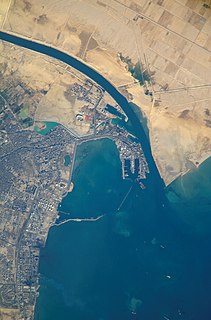
The Suez Canal is an artificial sea-level waterway in Egypt, connecting the Mediterranean Sea to the Red Sea through the Isthmus of Suez and dividing Africa and Asia. The canal is part of the Silk Road that connects Europe with Asia.

William Smith Otis was an American inventor of the steam shovel. Otis received a patent for his creation on February 24, 1839.
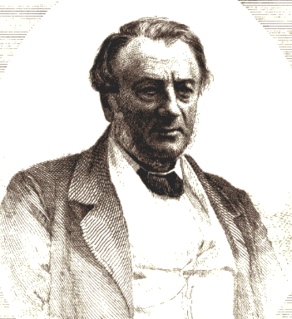
Barthélemy-Prosper Enfantin was a French social reformer, one of the founders of Saint-Simonianism. He was also a proponent of a Suez canal.

Excavators are heavy construction equipment consisting of a boom, dipper, bucket and cab on a rotating platform known as the "house". The house sits atop an undercarriage with tracks or wheels. They are a natural progression from the steam shovels and often mistakenly called power shovels. All movement and functions of a hydraulic excavator are accomplished through the use of hydraulic fluid, with hydraulic cylinders and hydraulic motors. Due to the linear actuation of hydraulic cylinders, their mode of operation is fundamentally different from cable-operated excavators which use winches and steel ropes to accomplish the movements.

Ferdinand Marie, Count de Lesseps was a French diplomat and later developer of the Suez Canal, which in 1869 joined the Mediterranean and Red Seas, substantially reducing sailing distances and times between Europe and East Asia.
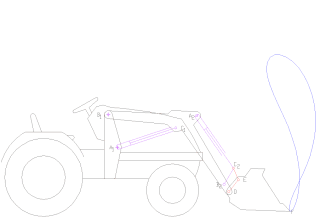
A loader is a heavy equipment machine used in construction to move or load materials such as soil, rock, sand, demolition debris, etc. into or onto another type of machinery.

Heavy equipment or heavy machinery refers to heavy-duty vehicles, specially designed for executing construction tasks, most frequently ones involving earthwork operations or other large construction tasks. Heavy equipment usually comprises five equipment systems: implementation, traction, structure, power train, control and information.

A dragline excavator is a piece of heavy equipment used in civil engineering and surface mining.
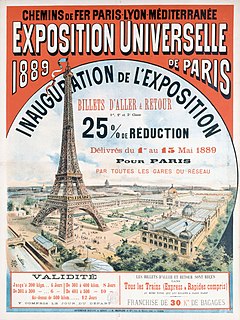
The Exposition Universelle of 1889 was a world's fair held in Paris, France, from 5 May to 31 October 1889. It was the fourth of eight expositions held in the city between 1855 and 1937. It attracted more than thirty-two million visitors. The most famous structure created for the Exposition, and still remaining, is the Eiffel Tower.

Dredging is the excavation of material from a water environment. Possible reasons for dredging include improving existing water features; reshaping land and water features to alter drainage, navigability, and commercial use; constructing dams, dikes, and other controls for streams and shorelines; and recovering valuable mineral deposits or marine life having commercial value. In all but a few situations the excavation is undertaken by a specialist floating plant, known as a dredger.
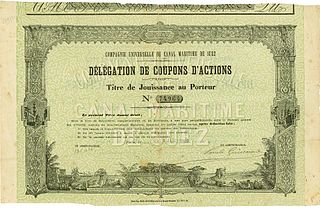
The Universal Company of the Maritime Canal of Suez was the concessionary company that constructed the Suez Canal between 1859 and 1869 and operated it until the Suez Crisis that had occurred in 1956. It was formed by Ferdinand de Lesseps in 1858, and it operated the canal for many years thereafter. Initially, French private investors were the majority of the shareholders, with Egypt also having a significant stake.

A steam shovel is a large steam-powered excavating machine designed for lifting and moving material such as rock and soil. It is the earliest type of power shovel or excavator. Steam shovels played a major role in public works in the 19th and early 20th century, being key to the construction of railroads and the Panama Canal. The development of simpler, cheaper diesel-powered shovels caused steam shovels to fall out of favor in the 1930s.

A bucket-wheel excavator (BWE) is a large heavy equipment machine used in surface mining.

A trencher is a piece of construction equipment used to dig trenches, especially for laying pipes or electrical cables, for installing drainage, or in preparation for trench warfare. Trenchers may range in size from walk-behind models, to attachments for a skid loader or tractor, to very heavy tracked heavy equipment.
A bucket is a specialized container attached to a machine, as compared to a bucket adapted for manual use by a human being. It is a bulk material handling component.

Paulin Talabot was a French railway and canal engineer. Educated at the École Polytechnique, Talabot started his career building canals. Inspired by George and Robert Stephenson's steam railways in England, he built a line to transport coal from the coal mines at La Grand-Combe to the Mediterranean at Nîmes, which opened in 1839. He visited England and became friends with Robert Stephenson, with whom he surveyed a route for a Suez Canal in 1847.

A bucket chain excavator (BCE) is a piece of heavy equipment used in surface mining and dredging. BCEs use buckets on a revolving chain to remove large quantities of material. They are similar to bucket-wheel excavators and trenchers. Bucket chain excavators remove material from below their plane of movement, which is useful if the pit floor is unstable or underwater.
Alexandre-Théodore Lavalley, was an engineer and French politician. Paul Borel and Lavalley were contractors of the Suez Canal Company who designed, built, and operated the dredging machines that finished excavation of the Suez Canal from 1864 to 1869 after the use of forced labor was disallowed.
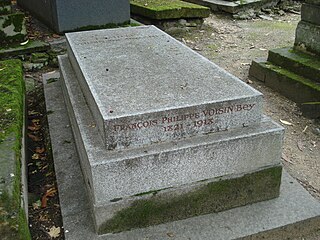
François Philippe Voisin, (Voisin-Bey) was a French engineer. He was a graduate of the École Polytechnique, an engineer for the Corps of Bridges, Waters and Forests, and was, from 1861 to 1870, the Chief Engineer for the Suez Canal Company in its construction of the Suez Canal.

Charles Joseph Lambert, also known as Lambert Bey was a French explorer and engineer.


















